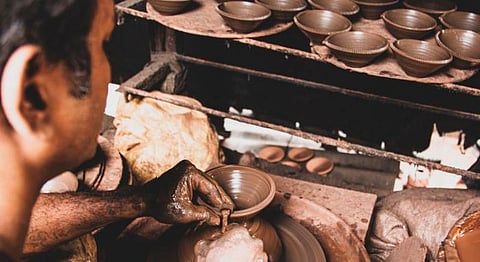
- HOMEGROWN WORLD
- #HGCREATORS
- #HGEXPLORE
- #HGVOICES
- #HGSHOP
- CAREERS
- ABOUT US
- CONTACT US

Khushi Choudhari, a resident of Mumbai, was eager to capture the lives of the Kumbharwada residents who are migrants from Gujarat. As per her research, this community, which sculpts pots of different sizes, is divided into 4 wadis/divisions. They make a whole range of things – from small cups for yoghurt to candles, larger water pots to ornamental vases.
As the name suggests, ‘Kumbhar’ means ‘potter’ and ‘Wada’ means ‘colony’. Kumbharwada is a 12-acre land, wherein the people of this area solely engage in the business of pottery. The people of Kumbharwada are perfect examples of the Make in India movement since they have carved their livelihood out of their own skills and do not depend upon any employer for work.
The potters live and work in the same area, making it a close-knit society or, in other words, a ‘community made by the people for the people’. They obtain their raw materials, i.e., the clay, from Virar and Mumbra. They mould this clay beautifully into desired shapes on the chaak or the wheel. Once crafted, these objects are kept in the sun to dry, after which they are baked in furnaces. Unlike the cracks on their feet, the broken edges on the pots they mould are smooth and filled with cement, so as to give it a final touch.
As you walk down the lanes, you’ll see that every stain of mud on their garment, every puddle of dirt, the smell of wet mud and clay and the tattered pile of gunny bags only speak of the craft and technique they possess. What our naked eye sees through these alleys is pure art. However, for them, it is just a skill they have developed over the years and that has become their profession. They do not consider themselves as artists and refer to each other as ‘Khumbhar’s’, i.e., potters.
Khushi emphasises that “90% of Mumbai’s earthenware comes from Kumbharwada. The potter families design their vessels by taking inspiration from their culture and blending it with the requirements of modern-day aesthetics. The hustle-bustle of the Kumbharwada gullys during festivals like Diwali and Makar Sankranti is worth experiencing.” She believes that one must visit Kumbharwada to take a look at the works of these artisans, as well as take back the memories of a village that is steeped with the art and culture of India.
If you enjoyed reading this article, we suggest you also read:
